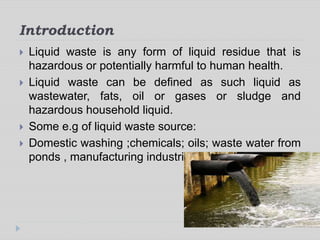A Biased View of Reclaim Waste
Table of ContentsSee This Report about Reclaim WasteThe Ultimate Guide To Reclaim WasteAbout Reclaim Waste8 Easy Facts About Reclaim Waste ShownGet This Report on Reclaim Waste
Explore the kinds, events, and kinds of liquid waste. Domestic sewer waste describes the waste and items from a residential septic system. This sort of waste is created by human beings in houses, schools, and other structures. This only includes sewage-disposal tanks that have a drain area. The proper management and disposal of residential sewage waste require liquid waste to be transferred to a sewer treatment plant where the proper techniques and equipment are related to purify and take care of waste.
Industrial waste frequently includes prospective hazards, such as flammable products or a mixture of fluid and strong waste items, and requires an advanced and thorough disposal procedure. The disposal of commercial waste commonly includes the filtering of waste before transportation to make sure secure and correct disposal. Hazardous waste is developed from by-products and drainage of commercial processes and manufacturing.
This sort of waste can not make use of the same sewage monitoring transportation or procedures as septic or industrial fluids. The industrial waste administration procedure calls for the evaluation and screening of fluid waste before it undergoes the disposal process (liquid waste removal). Runoff waste is the fluid waste that comes from runoff and excess stormwater in very booming areas or cities
Overflow waste can trigger contamination and flooding if not handled correctly. Making certain correct waste monitoring can prevent disasters and lower environmental damage.
Getting The Reclaim Waste To Work
Contact PROS Solutions today to learn more about our waste monitoring and disposal services and the correct ways to care for the liquid waste you generate.
(https://pubhtml5.com/homepage/kwjac/)This supposed 'wastewater' is not only an important source but, after treatment, will certainly be released to our land, waterways or the ocean. Made use of water from toilets, showers, baths, kitchen sinks, washings and industrial processes is recognized as wastewater.

water made use of to cool down equipment or clean plant and tools). Stormwater, a kind of wastewater, is runoff that moves from farming and urban areas such as roofings, parks, gardens, roadways, paths and gutters into stormwater drains, after rain. Stormwater moves neglected straight to regional creeks or rivers, eventually reaching the sea.
Unknown Facts About Reclaim Waste
In Queensland, many wastewater is treated at sewer therapy plants. Wastewater is delivered from residential or commercial websites through a system of sewage systems and pump terminals, understood as sewage reticulation, to a sewage therapy plant.
The Department of Natural Resources encourages city governments about handling, operating and maintaining sewage systems and treatment plants. In unsewered locations, city governments may need owners to set up private or house sewer therapy systems to treat residential wastewater from bathrooms, cooking areas, restrooms and washings. The Division of Natural Resources authorizes the usage of house systems when they are verified to be reliable.
A lot of stormwater obtains no therapy. In some new subdivisions, treatment of some stormwater to get rid of trash, sand and crushed rock has started utilizing gross pollutant catches. Wastewater therapy takes place in 4 stages: Removes solid issue. Larger solids, such as plastics and other things incorrectly released to sewers, are eliminated when wastewater is gone through screens.
Wastewater then flows into large containers where solids work out and are eliminated as sludge. Oil and scum are skimmed from the surface. Makes use of little living microorganisms called micro-organisms to damage reference down and get rid of continuing to be dissolved wastes and fine bits. Micro-organisms and wastes are integrated in the sludge. Removes nitrogen and phosphorus nutrients that might create algal blossoms in our waterways and endanger marine life.
Little Known Facts About Reclaim Waste.
Nutrient removal is not available at all sewer therapy plants due to the fact that it needs pricey specialist tools. Clear liquid effluent generated after treatment might still have disease-causing micro-organisms - liquid waste removal.

The majority of wastewater streams right into the sewage system. Under the Act, neighborhood governments carry out authorizations and licences for ecologically relevant activities (Periods) including wastewater releases that might have a regional influence.
What Does Reclaim Waste Do?
Surveillance provides factual info regarding water quality and can confirm that permit conditions are being satisfied. The info acquired via surveillance supplies the basis for making water high quality decisions.